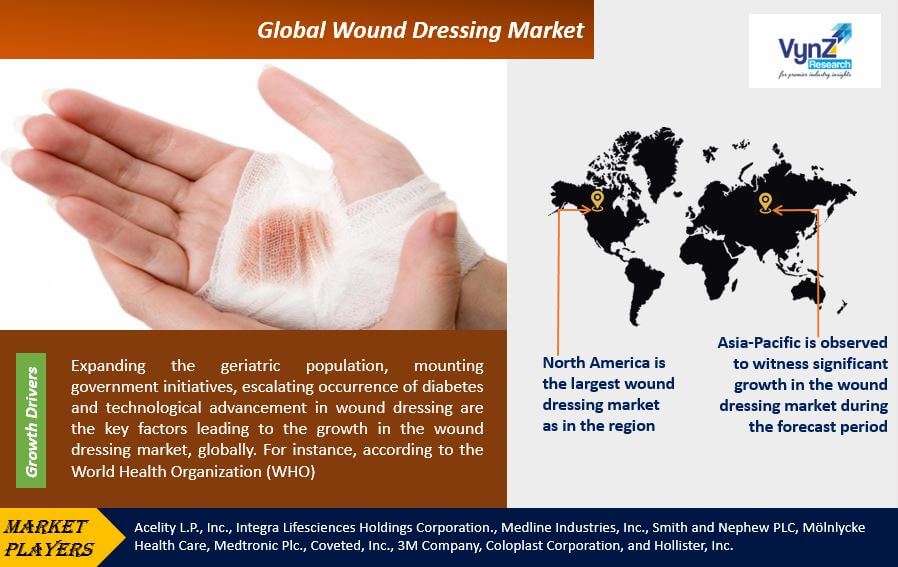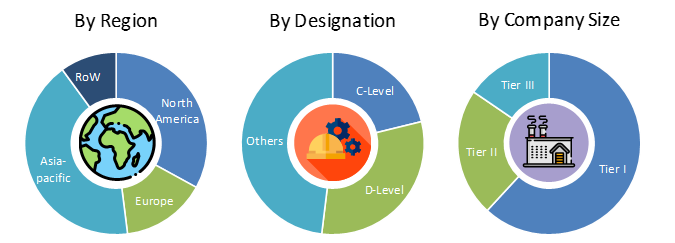| Status : Published | Published On : Dec, 2024 | Report Code : VRHC1105 | Industry : Healthcare | Available Format :

|
Page : 127 |

Global Wound Dressing Market – Analysis and Forecast (2025-2030)
Industry Insights by Product (Advanced, and Traditional), Application (Surgical Wounds, Pressure Ulcers, Diabetic Foot Ulcers, Burns, and Venous Ulcers), and by End User (Inpatient and Outpatient), and by Geography (North America, Europe, Asia-Pacific, Middle East, South America and Rest of the World)
Industry Overview
The Global Wound Dressing Market is predicted to grow at 5.9% CAGR during the forecast period with the market size reaching USD 17.3 billion by 2030. Chronic wound imposes a burden on an individual and the healthcare system. Wound healing is a complex process that requires a suitable environment to promote the healing process. Wound dressing helps to heal the wound and prevent issues such as complications or infection.

Different products of wound dressings such as advanced and traditional products contributed to the wound dressing market size. The market has witnessed significant demand for advanced wound dressing over the last few years due to escalating occurrence of diabetes-associated ulcers, pressure ulcers, and venous leg ulcers and the mounting need for inventive & innovative wound dressings for the treatment of such wounds.
Wound Dressing Market Segmentation
Insight by Product
Based on products, the wound dressing market is categorized into advanced, and traditional, of which advanced wound dressing holds the larger share in the wound dressing market, globally. Escalating occurrence of diabetes-associated ulcers, pressure ulcers, and venous leg ulcers and the mounting need for inventive & innovative wound dressings for the treatment of such wounds led to the faster growth of the advanced wound care dressing segment during the historical period, which is also predicted to continue during the forecast period.
The advanced wound dressing is further subdivided into foams, hydrogels, hydrofiber, films, collagen, alginates, wound contact layers, hydrocolloids, and super absorbents. Among all advance wound dressings, the foam segment accounted for the largest share of the market and is expected to grow at the fastest rate in the market, due to escalating patient awareness regarding advanced wound products, the mounting occurrence of diabetes, and expanding the geriatric population.
In addition, the traditional wound dressing segment is further subdivided into bandages, gauze, abdominal pads, sponges, and others. Among all traditional wound dressing, the bandages segment accounted for the largest share in the market. The market for gauze is expected to grow at the fastest rate in the market.
Insight by Application
On the basis of the application, the wound dressing market is segmented into surgical wounds, pressure ulcers, diabetic foot ulcers, burns, and venous ulcers. Of all, the surgical wound category is predicted to witness the highest CAGR during the forecast period and account for the largest share of the wound dressing market.
Insight by End User
On the basis of the end user, the market is segmented into inpatient and outpatient. Of all, the wound dressing market size for inpatients accounted for the largest share and is expected to grow at the fastest rate during the forecast period, globally.
Global Wound Dressing Market Report Coverage
|
Report Metric |
Details |
|
Historical Period |
2018 - 2023 |
|
Base Year Considered |
2024 |
|
Forecast Period |
2025 - 2030 |
|
Market Size in 2024 |
U.S.D. xx.x Billion |
|
Revenue Forecast in 2030 |
U.S.D. 17.3 Billion |
|
Growth Rate |
5.9% |
|
Segments Covered in the Report |
By Product, By Application and By End User |
|
Report Scope |
Market Trends, Drivers, and Restraints; Revenue Estimation and Forecast; Segmentation Analysis; Impact of COVID-19; Companies’ Strategic Developments; Market Share Analysis of Key Players; Company Profiling |
|
Regions Covered in the Report |
North America, Europe, Asia-Pacific, Middle East, South America and Rest of the World |
Industry Dynamics
Wound Dressing Market Growth Drivers
Expanding the geriatric population, mounting government initiatives, escalating occurrence of diabetes and technological advancement in wound dressing are the key factors leading to the growth in the wound dressing market, globally. In addition, according to IDF in 2017, globally approximately 425 million adults were suffering from diabetes and are expected to reach 629 million in 2045.
Technological advancements: Advancements in wound care technology have led to the development of innovative and advanced wound dressings. These include foam dressings, hydrocolloid dressings, alginate dressings, hydrogel dressings, and antimicrobial dressings. Technological advancements improve the efficacy of wound dressings and accelerate the healing process.
Increasing awareness about wound care: Healthcare professionals, patients, and caregivers are becoming more aware of the importance of proper wound care. This increased awareness has led to higher adoption of wound dressings for effective wound management and prevention of complications. plications.
Some of the other key factors driving the growth of the industry are the escalating awareness of novel technologies, the upsurge in the number of burn cases, the increasing number of surgeries, and mounting healthcare expenditure. For instance, according to the WHO, approximately 96% of mortal fire-related burns take place in low and middle-income countries.
Wound Dressing Market Challenges
Key factors hindering the growth of the wound dressing market are the high cost of technologically advanced products, and the incompetence of traditional wound dressing to treat acute wounds. Limited awareness and education: Despite growing awareness about wound care, there is still a need for improved education among healthcare professionals, patients, and caregivers regarding the selection and appropriate use of wound dressings. Lack of awareness can lead to suboptimal wound management practices and hinder the adoption of advanced wound dressings. Efforts to enhance education and training in wound care are crucial for market growth.
Recent Developments By the Key Players
ConvaTec partnered with AbbVie to offer VYALEV™ therapy for treating advanced Parkinson’s disease in the United States.
Acelity had expanded its portfolio through strategic acquisitions, including the purchase of Crawford Healthcare to enhance its advanced wound dressings offerings. This acquisition positioned Acelity as a global leader in advanced wound healing.
Wound Dressing Market Geographic Overview
Geographically, North America is the largest wound dressing market as in the region the occurrence of diabetes is augmenting. In addition, mounting awareness regarding wound care, escalating occurrence of acute and chronic wounds, mounting government initiatives, and favorable reimbursement policies are also fueling the growth of the North American wound dressing market.
Asia-Pacific is observed to witness significant growth in the wound dressing market during the forecast period, as the region comprises of a large population. Moreover, intensifying healthcare expenditure, the mounting occurrence of diabetes and chronic wound, and expanding research activity are also facilitating the significant growth of the Asia-Pacific wound dressing industry.
Wound Dressing Market Competitive Insight
Market players in the wound dressing industry are investing capital to develop technologically advanced systems.
Key players offering solutions for wound dressing include:
- Acelity L.P. Inc.
- Integra Lifesciences Holdings Corporation
- Medline Industries Inc.
- Smith and Nephew PLC
- Mölnlycke Health Care
- Medtronic Plc
- ConvaTec Inc.
- 3M Company
- Coloplast Corporation
- Hollister Inc.
The Wound Dressing Market report offers a comprehensive market segmentation analysis along with an estimation for the forecast period 2025–2030.
- Product
- Advanced
- Foams
- Films
- Hydrocolloids
- Wound Contact Layers
- Alginates
- Hydrofiber
- Traditional
- Abdominal Pads
- Bandages
- Sponges
- Gauzes
- Others
- Application Type
- Surgical Wounds
- Pressure Ulcers
- Burns
- Venous Ulcers
- Diabetic Foot Ulcers
- End User
- Inpatient
- Outpatient
Wound Dressing Market by Region
- North America
- U.S.
- Canada
- Mexico
- Europe
- Germany
- U.K.
- France
- Italy
- Spain
- Rest of Europe
- Asia-Pacific
- Japan
- China
- India
- Australia
- South Korea
- Rest of Asia-Pacific
- Rest of the World
- Brazil
- South Africa
- Saudi Arabia
- U.A.E
- Other Countries
PRIMARY RESEARCH INTERVIEWS - BREAKDOWN

Frequently Asked Questions
Purchase Options
Latest Report
Research Methodology
- Desk Research / Pilot Interviews
- Build Market Size Model
- Research and Analysis
- Final Deliverabvle
Connect With Our Sales Team
- Toll-Free: 1 888 253 3960
- Phone: +91 9960 288 381
- Email: enquiry@vynzresearch.com
Wound Dressing Market
